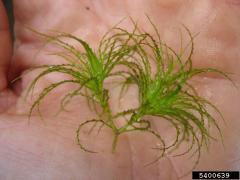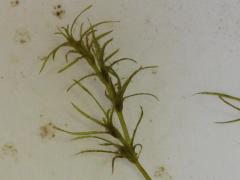Invasive Species: Najas minor, Brittleleaf Naiad
Brittleleaf naiad is an invasive annual forb that is native to Europe. The highly branched stems can grow up to 4 ft. (1.2 m) in length and fragment easily; hence the common name. Leaves are opposite, linear, and approximately 1 in. (2.5 cm) in length with prominent teeth along the margins. Flowering occurs in late spring to early summer, when small flowers develop in the axils of the leaves. Fruit are single-seeded. Germination of the seeds occurs in early spring. Brittleleaf naiad can be confused with coon’s tail (Ceratophyllum spp.) but can be distinguished by the leaf arrangement. The leaves of coon’s tail are arranged in whorls of four or five instead of the opposite arrangement of brittleleaf naiad. This invasive species was first collected in the United States in the 1930s.
What are invasive species and why should we be concerned about them?
Taxonomy: Scientific and Common Names for This Species
Najadales > Najadaceae > Najas minor All.
Synonym(s): brittle waternymph, brittleleaf naiad, European naiad, spinyleaf naiad, slender-leaved naiad
Najas minor – USDA PLANTS Profile
Distribution Maps
Brittleleaf naiad – The reported distribution of this invasive species across the United States. (Source: Invasive Plant Atlas of the United States)
Up-to-the-minute distribution maps and why they are important
Reporting This Invasive Species
What is the best way and place to report the occurrence of an invasive species?
How to report an invasive species sighting to EDDMapS – Early Detection & Distribution Mapping System
EDDMapS – Report an invasive species to EDDMapS
Cooperative Extension Offices – Find your local Cooperative Extension office on this map provided by USDA
How to Identify
This invasive species can be identified by looking for the characteristics described in the paragraphs that follow.
Plant
An invasive annual forb that is native to Europe. The highly branched stems can grow up to 4 ft. (1.2 m) in length and fragment easily; hence the common name.
 |
 |
| Graves Lovell, Alabama Department of Conservation and Natural Resources, bugwood.org | Nancy Loewenstein, Auburn University, bugwood.org |
Foliage
Leaves are opposite, linear, and approximately 1 in. (2.5 cm) in length with prominent teeth along the margins.
 |
 |
| Graves Lovell, Alabama Department of Conservation and Natural Resources, bugwood.org | Leslie J. Mehrhoff, University of Connecticut, bugwood.org |
Flower
Flowering occurs in late spring to early summer when small flowers develop in the axils of the leaves.
|
|
|
| bugwood.org | bugwood.org |
Fruit
Fruit are single-seeded. Germination of the seeds occurs in early spring.
| bugwood.org | bugwood.org |
Native Species That Resemble Brittleleaf Naiad
Najas guadalupensis, southern naiad – Images at invasive.org
 |
 |
| Robert Vidéki, Doronicum Kft., bugwood.org | Graves Lovell, Alabama Department of Conservation and Natural Resources, bugwood.org |
Najas flexilis, slender naiad – Images at invasive.org
 |
 |
| Rob Routledge, Sault College, bugwood.org | Rob Routledge, Sault College, bugwood.org |
Additional Images for Brittleleaf Naiad
Brittleleaf naiad – Images at Invasive.org
Learning Resources for Brittleleaf Naiad
Additional Information, Biology, Control and Management Resources
Control and management recommendations vary according to individual circumstances. Location, habitat, weather, and a variety of other conditions are factors that help determine the best treatment choice. To find the safest and most effective treatment for your situation, consult your state’s land-grant institution. If you will use chemicals as part of the control process, always refer to the product label.
United States Land-Grant University System – Find your land-grant university’s College of Agriculture, Cooperative Extension Service, or other related partner on this map provided by USDA.
Global Invasive Species Database – Invasive Species Specialist Group
Invasive Plant Atlas of New England – EDDMapS.org
Aquatic Nuisance Species Program – Aquatic Nuisance Species Program, SCDNR
Flora of North America – eFloras.org
Fact Sheet – Rhode Island Department of Environmental Management
